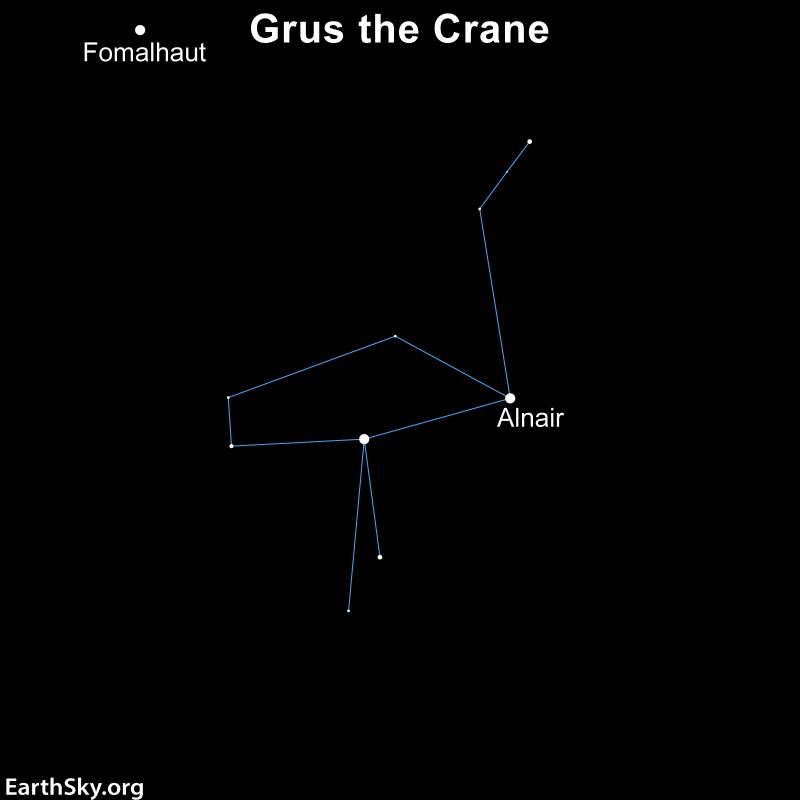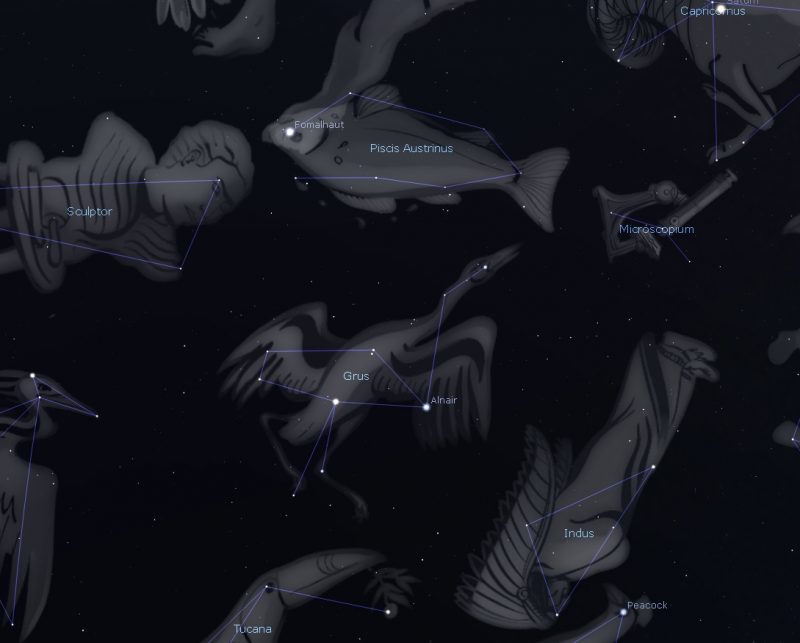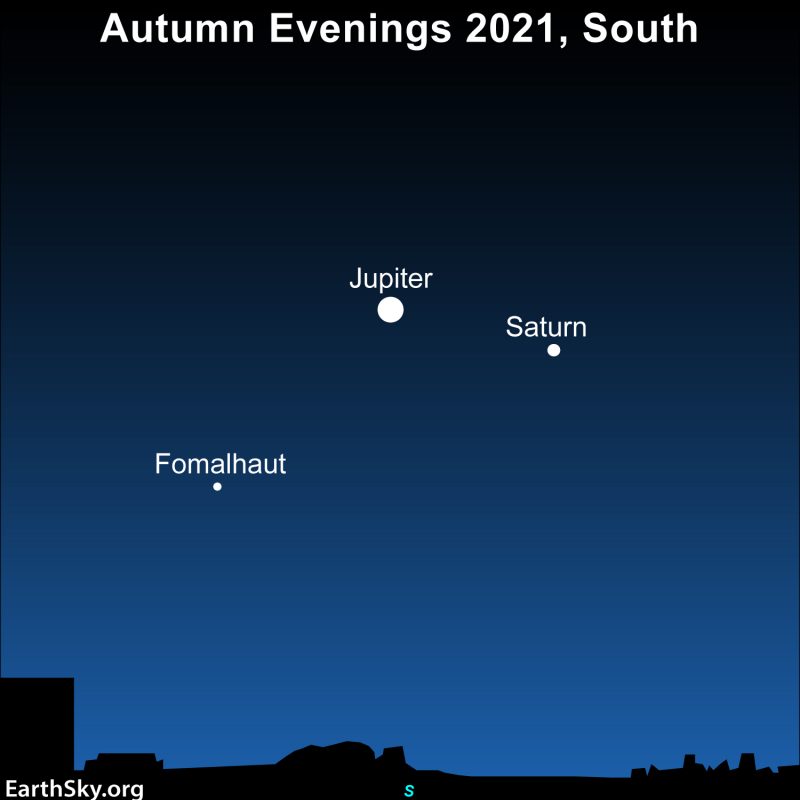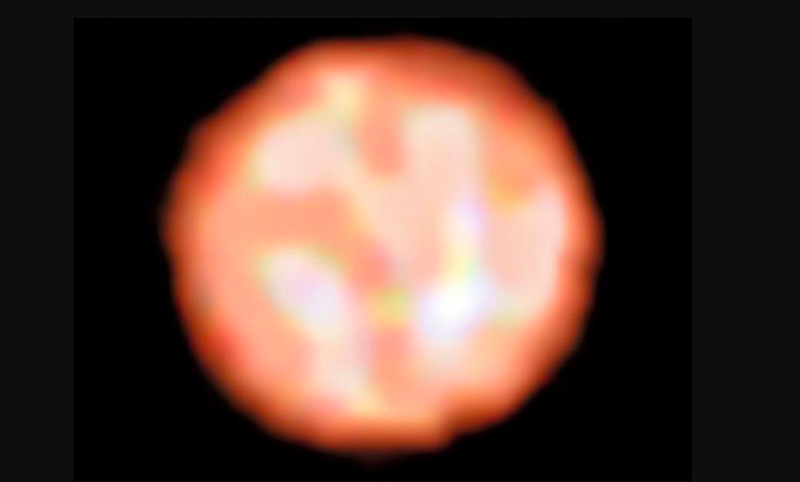
How to find Grus
The constellation Grus the Crane is located adjacent to Piscis Austrinus the Southern Fish, with its bright star Fomalhaut. October evenings are a good time to look for Grus. For us in the Northern Hemisphere, Grus is arcing across our southern sky each evening now. It’s south of (below) Fomalhaut. In 2021, Grus is also south of (below) two bright planets, Jupiter and Saturn. For locations farther south – such as Melbourne, Australia – the Crane passes near the sky’s zenith – or point directly overhead – during the evening hours in October.
The stars of Grus do resemble a crane with dangling legs and a long, curving neck. Even though it’s in the southern sky, people in the mid-latitudes of the Northern Hemisphere can still catch a glimpse of Grus. Imagine it running along a beach marked by the southern horizon.


Stars of Grus the Crane
The brightest star in the constellation Grus is Alnair. Also known as Alpha Gruis, Alnair is magnitude 1.7 and lies 101 light-years away. Alnair means the bright one in Arabic. This subgiant star is more than twice as hot as our sun and more than three times as wide. Alnair spins 120 times faster than the sun.
The second-brightest star in Grus, Beta Gruis at magnitude 2.0, lies where the bird’s body and legs connect. Beta Gruis is a bit farther than Alnair at 170 light-years away. The double star Delta 1 and Delta 2 Gruis mark the top center of the body. The stars are magnitude 3.9 and 4.1 and lie 16 arcminutes apart. You should be able to separate them without optical aid, but they’re also a good pair to explore with binoculars. Continuing to the other side of the crane’s body are two stars, Iota Gruis at magnitude 3.8 and Theta Gruis at magnitude 4.2.
Magnitude 3.0 Gamma Gruis marks the head of the crane. The long, dangling legs of the crane contain the dim stars Epsilon Gruis at magnitude 3.4 and Zeta Gruis at 4.1.
Deep-sky targets in Grus
Grus holds no good deep-sky observing targets for anyone with modest observing equipment. For those with large telescopes, the best option in Grus is to focus on the brightest star in the constellation, Alnair. Putting this star in the field of view of a telescope will also include a dim magnitude 10.5 galaxy just 16 arcminutes away. This lenticular galaxy, called NGC 7213, is an active galaxy that may contain two jets.

Expert astrophotographers occasionally focus on Grus to capture a quartet of galaxies: NGC 7552, NGC 7582, NGC 7590 and NGC 7599. The Grus Quartet contains four spiral galaxies that lie 55 to 70 million light-years away. A close inspection of an image of them reveals more galaxies hundreds of millions of light-years beyond the quartet.
Science of Grus
Astronomers took the first detailed image of the surface of a giant star using a star in Grus. The star, Pi1 Gruis, is 530 light-years from Earth. While the star has about the same mass as our sun, it’s 350 times larger and several thousand times brighter. The red giant star is coming to the end of its life and provides a preview of what will happen to the sun.

Bottom line: Grus the Crane is a constellation best seen from the Southern Hemisphere that has one notably bright star, Alnair, whose name actually means the bright one.
The post Grus the Crane, home to ‘the bright one’ first appeared on EarthSky.
from EarthSky https://ift.tt/30VDQrV

How to find Grus
The constellation Grus the Crane is located adjacent to Piscis Austrinus the Southern Fish, with its bright star Fomalhaut. October evenings are a good time to look for Grus. For us in the Northern Hemisphere, Grus is arcing across our southern sky each evening now. It’s south of (below) Fomalhaut. In 2021, Grus is also south of (below) two bright planets, Jupiter and Saturn. For locations farther south – such as Melbourne, Australia – the Crane passes near the sky’s zenith – or point directly overhead – during the evening hours in October.
The stars of Grus do resemble a crane with dangling legs and a long, curving neck. Even though it’s in the southern sky, people in the mid-latitudes of the Northern Hemisphere can still catch a glimpse of Grus. Imagine it running along a beach marked by the southern horizon.


Stars of Grus the Crane
The brightest star in the constellation Grus is Alnair. Also known as Alpha Gruis, Alnair is magnitude 1.7 and lies 101 light-years away. Alnair means the bright one in Arabic. This subgiant star is more than twice as hot as our sun and more than three times as wide. Alnair spins 120 times faster than the sun.
The second-brightest star in Grus, Beta Gruis at magnitude 2.0, lies where the bird’s body and legs connect. Beta Gruis is a bit farther than Alnair at 170 light-years away. The double star Delta 1 and Delta 2 Gruis mark the top center of the body. The stars are magnitude 3.9 and 4.1 and lie 16 arcminutes apart. You should be able to separate them without optical aid, but they’re also a good pair to explore with binoculars. Continuing to the other side of the crane’s body are two stars, Iota Gruis at magnitude 3.8 and Theta Gruis at magnitude 4.2.
Magnitude 3.0 Gamma Gruis marks the head of the crane. The long, dangling legs of the crane contain the dim stars Epsilon Gruis at magnitude 3.4 and Zeta Gruis at 4.1.
Deep-sky targets in Grus
Grus holds no good deep-sky observing targets for anyone with modest observing equipment. For those with large telescopes, the best option in Grus is to focus on the brightest star in the constellation, Alnair. Putting this star in the field of view of a telescope will also include a dim magnitude 10.5 galaxy just 16 arcminutes away. This lenticular galaxy, called NGC 7213, is an active galaxy that may contain two jets.

Expert astrophotographers occasionally focus on Grus to capture a quartet of galaxies: NGC 7552, NGC 7582, NGC 7590 and NGC 7599. The Grus Quartet contains four spiral galaxies that lie 55 to 70 million light-years away. A close inspection of an image of them reveals more galaxies hundreds of millions of light-years beyond the quartet.
Science of Grus
Astronomers took the first detailed image of the surface of a giant star using a star in Grus. The star, Pi1 Gruis, is 530 light-years from Earth. While the star has about the same mass as our sun, it’s 350 times larger and several thousand times brighter. The red giant star is coming to the end of its life and provides a preview of what will happen to the sun.

Bottom line: Grus the Crane is a constellation best seen from the Southern Hemisphere that has one notably bright star, Alnair, whose name actually means the bright one.
The post Grus the Crane, home to ‘the bright one’ first appeared on EarthSky.
from EarthSky https://ift.tt/30VDQrV

Aucun commentaire:
Enregistrer un commentaire